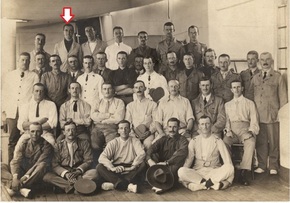
MACDONALD, Neil
| Service Number: | Officer |
|---|---|
| Enlisted: | Not yet discovered |
| Last Rank: | Lieutenant |
| Last Unit: | 23rd Infantry Battalion |
| Born: | Ballarat, Victoria, Australia, date not yet discovered |
| Home Town: | Ballarat, Central Highlands, Victoria |
| Schooling: | Not yet discovered |
| Occupation: | Clerk |
| Died: | Died of Wounds, France, 29 July 1916, age not yet discovered |
| Cemetery: |
Warloy-Baillon Communal Cemetery Extension |
| Memorials: |
World War 1 Service
| Date unknown: | Involvement Lieutenant, Officer, 23rd Infantry Battalion |
|---|
Intro A Mothers Loss – The Story of 2 Geelong Brothers
On Sunday the 25th April 1915 Australian and New Zealand soldiers waded ashore at a small cove called Ari Burnu which later was to become known as ANZAC Cove.
Meanwhile back in Australia on the 8th May 1915 Neil MacDonald joined the Australian Imperial Force as a 2nd Lieutenant in the 23rd Battalion. He was born in Ballarat on the 2nd August 1893 and his next of kin was listed as his father who lived at 132 Yarra Street Geelong.
The 23rd Battalion was raised in 1915 as part of the Australian Imperial Force and formed part of the 6th Brigade, attached to the 2nd Division.
On the 26th August 1915 Neil was promoted to Lieutenant and he along with his battalion was committed to the Gallipoli Campaign as reinforcements on the 4 September, arriving there at 9:30 pm that evening.
A day of familiarisation followed before the battalion took up defensive positions at Lone Pine.
On 12 September the 23rd took over responsibility for the post manning positions that, in some places, were only a few metres from the Turkish trenches ,Neil and his men began countermining operations after Turkish mining operations were discovered. For the next three months, due to the intensity of the fighting in the sector, Neil and the battalion alternated their position with the 24th Battalion almost every day until the evacuation of Allied troops from the peninsula occurred with the last troops leaving on the night of 19/20 December 1915.
Following their withdrawal from Gallipoli, Neil and the Battalion were moved to Lemnos Island, where they remained until January 1916 when they were transferred back to Egypt to rebuild their strength and conduct further training in preparation for its transfer to Europe where Neil and the battalion arrived in France in March 1916, the battalion moved to the Western Front, occupying the forward positions around Armentières in northern France on 10 April 1916. In mid-July, we find Neil and the battalion transferring to the Somme where he subsequently took part in the Battles of Pozières which commenced on the 23rd July.
From the Official History of Australia in the War by Charles Bean
The final objective-the Ovillers-Courcelette road-lay 200
yards farther on. It was not being bombarded, the barrage lying on Park Lane a strong trench 200 yards beyond but it was defended-although the 23rd were unaware of this. The garrison of one post appears to have been caught, but the rest fled before the approach of the Victorians, whose first two waves crossed the track and the outpost positions without recognising either and continued on towards Park Lane, on which the barrage of the British artillery was falling.
This trench was strongly held but the leading waves of Victorians were within a few yards of it under withering fire and a few men on the right and left are said to have actually penetrated it before the error was discovered. The troops were also in the fringe of their own barrage, and the loss was severe. The majority of these had been killed and were never heard of again. The total loss
of the 23rd was 7 officers,5 of them killed and 326 other ranks.
Neil MacDonald was one of these officers he was admitted to the 12th South Midlands field ambulance suffering horrific injuries to his chest and back and died shortly thereafter. He was 22 years old. He now lies in the Warloy-Baillon Cemetery in France.
Charles Bean wrote that Pozières ridge "is more densely sown with Australian sacrifice than any other place on earth."
Submitted 5 January 2025 by Steve Chilvers









